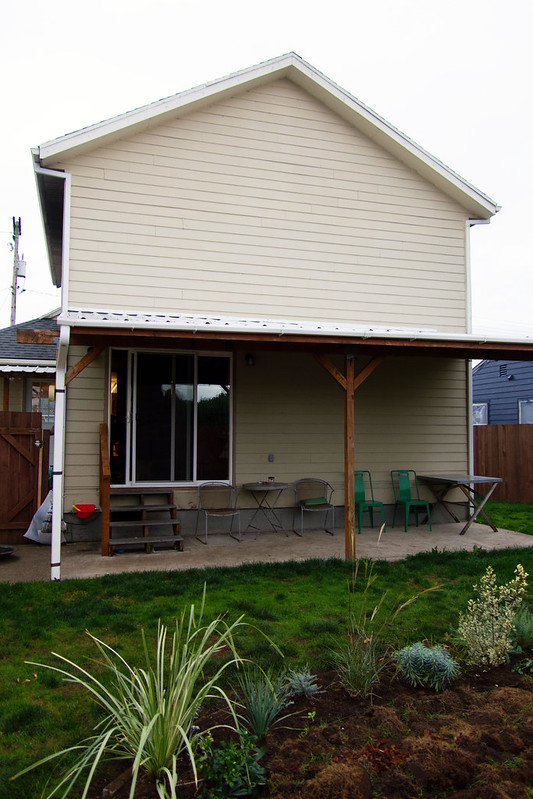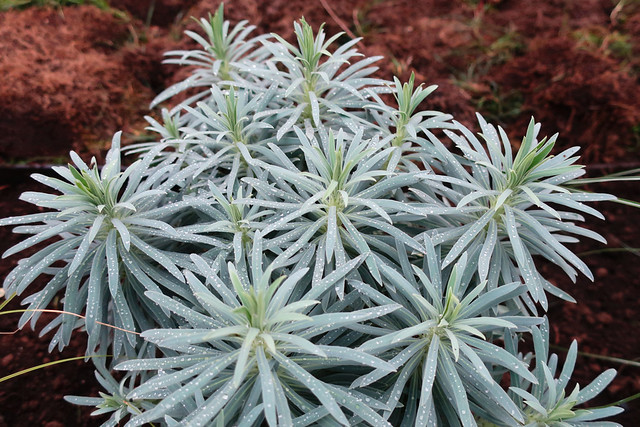We’ve been at the Oregon house a little over two weeks, and this Tillamook Rainforest coastal area is now settling into a comfortable steady rain. Late October and November bring some of the heaviest rainfall to the yearly total over 80 inches. Most of the rain is distributed in fall, winter, and spring, but I’m told there is occasional summer rain too here at the coast.
There is a small, squarish, fenced-in backyard facing south. The first week it was still relatively dryish and the ground workable, so the second day after arrival I was stripping sod, trying to avoid harming the zillions of disturbed earthworms, and getting what plants I brought into the ground in the sunniest band of soil available. The backyard previously supported four kids and three dogs, so the wise parents chose half grass and half bark mulch for optimal mud-free play surfaces. The soil under the sod is beautiful loam. Under the mulch and landscape cloth was an entirely different story.
Amazing what depriving soil of oxygen will do. Pulling back the bark mulch and landscape cloth revealed slick plasticine, completely unplantable. About a 4-foot wide strip of the mulched area is in sun by noon, so the landscape cloth and mulch were pulled away and the clumps of stripped sod were piled on top, roots up, so the earthworms could wriggle their way out of the clumps and work their magic with the slick clay. I’d love to plant it in late spring but it may still be unworkable. Yet to be determined is whether the entire mulched area is in sun by summer or remains somewhat shaded. I’ll most likely remove all the grass for planting and paths and will decide on the mulched areas next year.
A rummage sale over the weekend improbably produced, amongst the housewares and old furniture, my old buddy tetrapanax and a potful of fall-blooming kaffir lilies, schizostylis, a South African bulb for zones 7-9 that likes it really wet. I saw it flourishing this late October in a local garden, drew a blank on ID (too late for crocosmia?) and then there it was miraculously at the rummage sale, potted and labeled. My first local plant! The seller of the tetrapanax carefully explained to me how this gunnera was a hardy gunnera unlike the more familiar Gunnera manicata. After that lengthy dissertation, politeness seemed to require that I leave the plant ID unchallenged, and so I did.
On a short trip south on highway 101 I noticed growing fields of dahlias. A return trip was made over the weekend to Old House Dahlias and a handful of tubers ordered for spring after inspecting the dahlias’ performance in the muddy growing fields. I’m particularly excited about ‘Orange Pekoe,’ which looked amazingly strong and healthy for late October. The little vegetable garden will probably be at peak capacity with just the dahlias alone. (Edited to add 4/21/22: dahlias were picked up from OHD last weekend, offered as an alternative to mail delivery, about 10 minutes south from us on Hwy 101. ‘Orange Pekoe’ was the one dahlia not included in the order because of rot. Compensation was made in huge clumps of ‘Elks Lips on Fire’ and ‘Comano Sitka.’)
Front gardens in my neighborhood are sparsely planted with Japanese maples, hydrangeas, fuchsias, rhododendrons, pieris, hebes, and tend to be mostly lawn and foundation shrubs, with everything meticulously mulched. Lots of Lithodora diffusa, and I’ve even spotted a monkey puzzle tree. And of course conifers. A shrub I was semi-interested in, the cutleaf sumac, has taken over a nearby front yard and is in blazing autumnal color, but now I think I’ll pass. It looks like plants can really get away from you here!
We are all busy exploring this beautiful part of the country. Marty is in love with his new granddaughter, the local oysters, the pellet stove and already has a little boat to get ready for river trips. Billie loves her walks, rainy or dry, though I still haven’t decided whether to get her a little raincoat. A washer was installed yesterday so all major appliances are now accounted for. We still run outside to check out the geese formations as they honk overhead, which the neighbors must find very amusing. But as Ms. Austen says, for what do we live, but to make sport for our neighbors?
Hope you are well! Much love, AGO







The soil under the plastic may recover much faster there than it would here where it is dry dry dry dry. The downside will be weeds, right? Can’t imagine 80 inches of rain…that’s about 10 years worth here.
Looks lovely, best wishes for much happiness in your new part-time home.
I’m so excited for you. What an adventure, to start a garden in a completely different climate. I love your approach: “whatever survives the winter will be the bones of the new garden.”
Your rummage sale finds are a good omen, and the shed is an awesome bonus!
Looking forward to more posts from Tillamook. In the meantime, I’ll try to wrap my brain around the notion of 80″ of rainfall!
Such fun! Good for you, digging right in. The somewhat uninspired neighborhood plantings may partially be due to deer: the shrubs you noted have all been resistant to them at my Astoria residence. I’m excited for you, for all good reasons!
This is so exciting, Denise. I expect there’s a lot of work in front of you but I bet it’ll be fun to experiment with plants in a climate so different than our SoCal gardens. The clay soil sounds disgusting but I’m sure it can be made more workable over time. Good for you ordering dahlia tubers!
I’m glad Banksy made the car trip – maybe he’ll get used to it in time, or maybe Billie will shape him up. Have you visited that attic yet?
Lordy I would be out spending all my plant budget on dwarf conifers. The most rain I’ve clocked in here is 60″ many years past . But 80 , yikes. Cozy and comfortable indoor spaces are key . What fun it will be to start planting that up-we’ll enjoy following along.
80 inches of rain? Yikes! How wonderful that you have a working space (shed) already constructed and that overhang in the back is so you! (shades of your LB garden… although not nearly as charming—yet). Glad you found that special gunnera (!) and I think a cutleaf sumac can get away from anyone anywhere! Hopefully you’ll be up in Tillamook next spring when we have our bloggers plant swap and zoom on over to the Portland area to join us.
How exciting! From a prior life spent in the Pacific NW, I most remember lilacs, and gladiolus, daffodils, and rhododendrons — but mostly the delicious lilacs. It’s a whole different world up there. The endless gray days will make you crave color. Nothing wrong with that. Have a wonderful time adjusting to your new environs. Nothing quite like a new adventure. And congratulations on your new grandbaby, too!